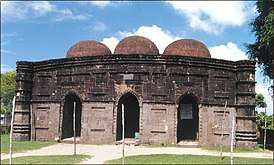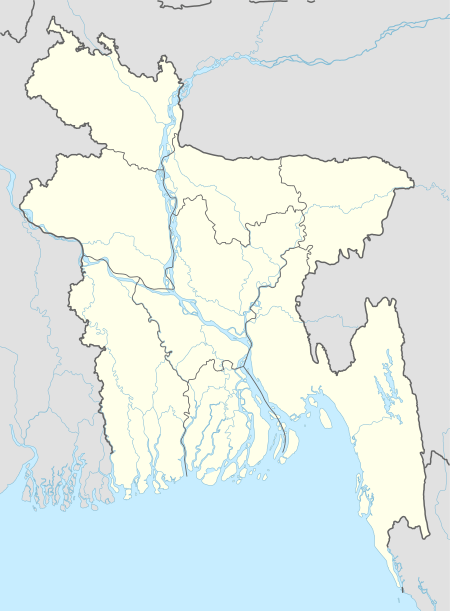Kusumba Mosque
Kusumba Mosque (Bengali: কুসুম্বা শাহী মসজিদ) is a mosque in Manda Upazila of Naogaon District, Bangladesh. It was built in 1558-59.[1]
| Kusumba Mosque | |
|---|---|
 Kusumba Mosque | |
| Religion | |
| Affiliation | Islam |
| Location | |
| Location | Naogaon, Bangladesh |
 Shown within Bangladesh | |
| Geographic coordinates | 24.7535°N 88.6815°E |
| Architecture | |
| Type | Mosque |
| Style | Islamic Architecture |
| Completed | 1558-59 |
| Specifications | |
| Length | 58' |
| Width | 42' |
Location
On the west bank of Atrai river, under the Manda Upazila of Naogaon District in Bangladesh, the mosque named Kusumba.
History
Kusumba Mosque is named after the village of Kusumba. It was built during the period of Afghan rule in Bangladesh by a high-ranking official named Sulaiman. It was built under one of the last Suri rulers. His name was Ghiyasuddin Bahadur Shah. Although the mosque was built under the suri rule, the architectural pattern was not influenced by the earlier Suri architecture of North India. It was constructed with a Bengal style. At the eastern central entrance, inscription mentioned the time period of construction of the mosque to 966 AH (1558-59 AD).
Current condition
The mosque was badly damaged during the earthquake in 1987. Kusumba Mosque is also known as Kala Pahar (কালা পাহাড়), meaning black mountain, or Kala Rotno (কালা রত্ন) which means Black Gem. Possible reason: During the massive earthquake of 1897 the mosque was damaged severely, but stood firmly. Another reason can be for such name is the black plaster of stones at the outer wall. Now the mosque is protected by the Department of Archaeology of Bangladesh. The mosque is an attraction that is marveled at and studied, due its wonderful architectural style and elaborate decorations.[2]
Structure
The mosque lies inside a walled enclosure with a monumental gateway with standing spaces for guards. The inscription tablet is totally in Arabic, except the part "built by" is in Persian.Walking up to the mosque, visitors will be greeted by a massive gateway, which is the only entrance to the mosque that is protected by a surrounding wall. One can almost imagine the guards outside, still protecting this breathtaking building. The foundation and most of the building was constructed from bricks, although the outer walls, some interior walls, side screens and columns are of stone.
The central Mihrab is designed in the west. Opposite the central and southeastern entrances, the interior west wall has two mihrabs. There is division in the two mihrabs and they had different platforms. That is because the time of construction the general public was separated from officials and nobility during the prayers.[3][4]
References
- "Kusumba Mosque". banglapedia. Retrieved 18 June 2020.
- Architecture By Asiatic Society Bangladesh
- Ghosh, Nihar (2003). Islamic Art of Mediaeval Bengal Architectural Embellishments. Suchetana. OCLC 56368557.
- Hasan, Perween (2007). Sultans and Mosques: The Early Muslim Architecture of Bangladesh. I.B.Tauris. pp. 195–197. ISBN 978-1-84511-381-0.
Further reading
| Wikimedia Commons has media related to Kusumba Mosque. |
- Hasan, Perween (2012). "Kusumba Mosque". In Islam, Sirajul; Jamal, Ahmed A. (eds.). Banglapedia: National Encyclopedia of Bangladesh (Second ed.). Asiatic Society of Bangladesh.
_002.jpg)